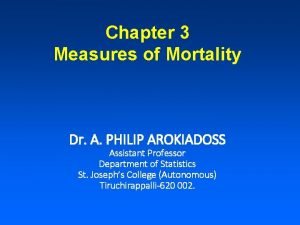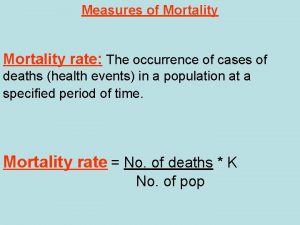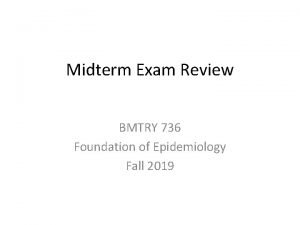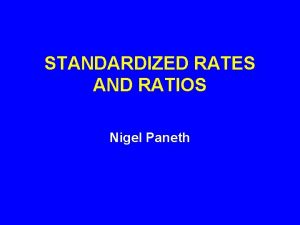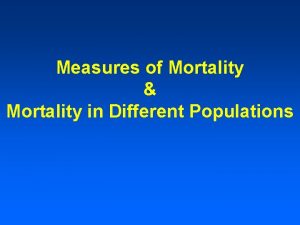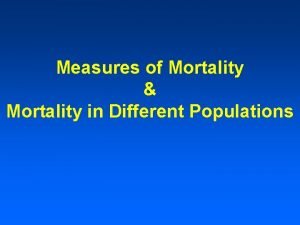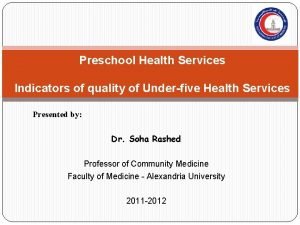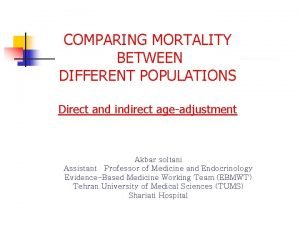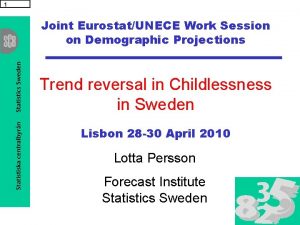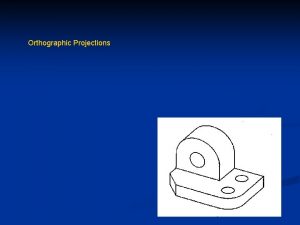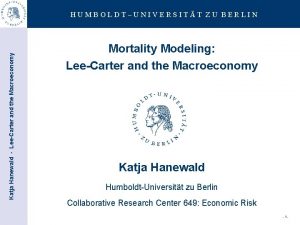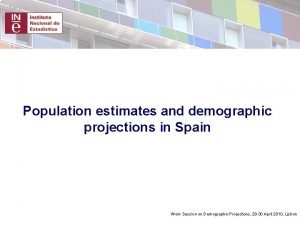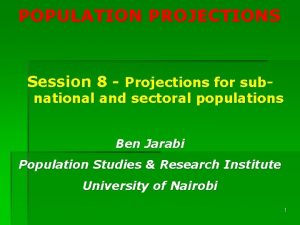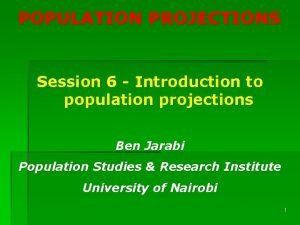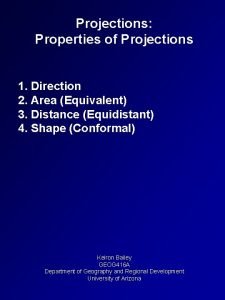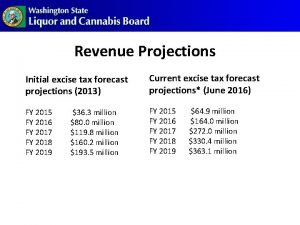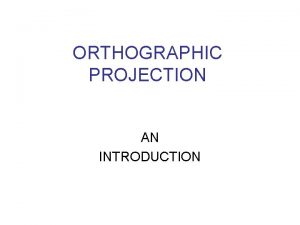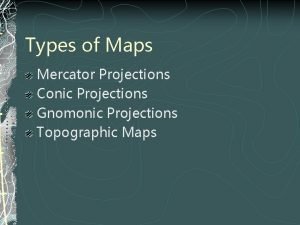EurostatUNECE Work Session on Demographic Projections LeeCarter Mortality

















- Slides: 17

Eurostat/UNECE Work Session on Demographic Projections Lee-Carter Mortality Projection with "Limit Life Table" Jorge Miguel Bravo University of Évora (Deparment of Economics) and CEFAGE -UE Lisbon, Portugal, 29 th April 2010 © Jorge Miguel Bravo 1

Agenda 1. Introduction and motivation 2. Classical Lee-Carter mortality modelling 3. Lee-Carter Model with "Limit Life Table“ 4. Implementation issues 5. Concluding remarks and further research © Jorge Miguel Bravo 2

Mortality forecasting methods • Mortality forecasting methods currently can be classified into 1. Explanatory methods Based on structural or causal epidemiological models, analyze the relationship between age-specific risk factors (e. g. , smoking) and mortality rates 2. Expert-opinion based methods Involve the use of informed expectations about the future, alternative low/high scenarios or a targeting approach 3. Extrapolative methods Assume that future mortality patterns can be estimated by projecting into the future trends observed in the recent to medium -term past (e. g. , Lee-Carter, APC methods) © Jorge Miguel Bravo 3

Extrapolative methods • Why do we use extrapolative methods? Because. . . – of the inherent complexity of the factors affecting human mortality – of the current lack of understanding of the intricate mechanisms governing the aging process • – of the relative stability of the past demographic trends – they offer a reliable basis for projection So what’s the problem? “. . . using extrapolative methods is like driving a car through the rear mirror. . . !” © Jorge Miguel Bravo 4

Extrapolative methods: limitations • Since the methods rely on the assumption that future mortality trends will continue into the future as observed in the past, they may – generate biologically implausible scenarios (e. g. , null mortality rates for all ages) – produce implausible age patterns § Crossover of consecutive mortality rates § Crossover of male/female life expectancy – © Jorge Miguel Bravo produce increasing divergence in life expectancy 5

Classical AP Lee-Carter model • Age-Period demographic model • Identification constraints • Fitting method: OLS by Singular Value Decomposition (SVD) • Forecasting: Age effects ( x and x) are assumed constant + a time series ARIMA (p, d, q) model for the time component (kt) • Problem: Asymptotic behavior of the model © Jorge Miguel Bravo 6

AP Lee-Carter model © Jorge Miguel Bravo 7

AP LC Model with “Limit Life Table” • Basic idea (Bravo, 2007) – There is a “target” life table to which longevity improvements over time (over a projection horizon) converge – We explicitly admit that there are (at least in a limited time horizon) natural limits to longevity improvements • Rationale – there is a decline in the physiological parameters associated with ageing in humans duration of life is limited? – stylized facts: slowdown in life expectancy at birth increases observed in many developed countries © Jorge Miguel Bravo 8

AP LC Model with “Limit Life Table” • Hip. 1: the age-specific forces of mortality are constant within each rectangle of the Lexis diagram • Hip. 2: Let denote the instantaneous death rate or probability of death corresponding to this “target” life table • Hip. 3: AP LC model is formulated within a Generalized Linear Model (GLM) framework with a generalized error distribution age- and period-specific numbers of deaths are independent realizations from a Poisson distribution with parameters © Jorge Miguel Bravo 9

AP LC Model with “Limit Life Table” • Age-Period demographic model with identification constraints • GLM model of the response variable Dx, t with logarithmic link and non-linear parameterized predictor © Jorge Miguel Bravo 10

AP LC Model with “Limit Life Table” • Fitting method: ML methods with theory-based distributional assumptions instead of empirical measures (i. e. , OLS) • Parameter estimates are obtained by maximizing the loglikelihood function with © Jorge Miguel Bravo 11

AP LC Model with “Limit Life Table” • Because of the log-bilinear term xkt we cannot use standard statistical packages that include GLM Poisson regression • Solution: Use an iterative algorithm for estimating log-bilinear models developed by Goodman (1979) based on a Newton. Raphson algorithm Updating-scheme • Adjust parameter estimates to meet identification constraints • Forecasting: Age effects ( x and x) constant and a time series ARIMA (p, d, q) model for the time component (kt) © Jorge Miguel Bravo 12

Implementation issues • We need a “limit/target” life table as input subjective/informed assumptions about the future development of a set of important biological, economic and social variables have to be made • Alternative approaches – Use an epidemiological model to define the target life table (TLT) – Consider the life table of a more advanced population as TLT – Use the observed gaps between countries and regions – combination of the lowest mortality rates observed by sex-age groups – estimates of the lowest achievable cause-specific death rates – Calibrate some mortality law to express different scenarios on the main trends in human longevity (e. g. , rectangularization survival curve, life expectancy trends, median, mode, entropy, IQR, . . . ) © Jorge Miguel Bravo 13

Implementation issues • Duchêne and Wunsch (1988) hypothetical limit life table © Jorge Miguel Bravo 14

Implementation issues • 2 nd Heligman-Pollard (1980) mortality law © Jorge Miguel Bravo 15

Concluding remarks • The asymptotic behaviour of the AP LC is unsatisfactory • We argue that a combination of expert-opinion and extrapolative methods can be used to forecast mortality rates within the Lee. Carter framework limit/target life table • The key implementation is the definition of the “target” life table • Future research – Experiment with alternative parameterizations of the GLM demographic model (e. g. , age-specific rates of convergence) – Consider cohort-specific “targets” – Consider gender-specific “targets” – … © Jorge Miguel Bravo 16

Eurostat/UNECE Work Session on Demographic Projections THANK YOU JORGE MIGUEL BRAVO (jbravo@uevora. pt) © Jorge Miguel Bravo 17
 Age adjusted mortality rate definition
Age adjusted mortality rate definition Health continuum pdhpe
Health continuum pdhpe Mortality in the great gatsby
Mortality in the great gatsby Ukuran morbiditas adalah
Ukuran morbiditas adalah Death rate formula
Death rate formula The cause-specific mortality rate from roller-skating was:
The cause-specific mortality rate from roller-skating was: Attributable mortality
Attributable mortality Disease specific mortality rate formula
Disease specific mortality rate formula Nir ap human geography
Nir ap human geography Infant mortality rate formula
Infant mortality rate formula Age adjusted mortality rate
Age adjusted mortality rate Death rate formula
Death rate formula Mortality formula
Mortality formula Equations
Equations Infant mortality rate formula
Infant mortality rate formula Miracle plays and morality plays
Miracle plays and morality plays Indirect age adjustment
Indirect age adjustment Morbidity and mortality
Morbidity and mortality
